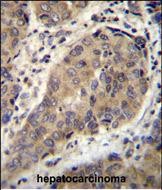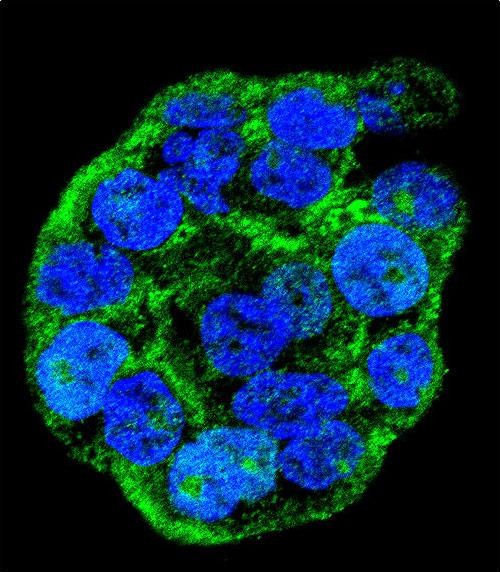WTIP Antibody (C-term)
Affinity Purified Rabbit Polyclonal Antibody (Pab)
- 产品详情
- 实验流程
- 背景知识
Application
| WB, IHC-P, IF, E |
|---|---|
| Primary Accession | A6NIX2 |
| Other Accession | Q7TQJ8 |
| Reactivity | Human, Mouse |
| Predicted | Mouse |
| Host | Rabbit |
| Clonality | Polyclonal |
| Isotype | Rabbit IgG |
| Calculated MW | 45124 Da |
| Antigen Region | 243-271 aa |
| Gene ID | 126374 |
|---|---|
| Other Names | Wilms tumor protein 1-interacting protein, WT1-interacting protein, WTIP |
| Target/Specificity | This WTIP antibody is generated from rabbits immunized with a KLH conjugated synthetic peptide between 243-271 amino acids of human WTIP. |
| Dilution | WB~~1:1000 IHC-P~~1:100~500 IF~~1:10~50 E~~Use at an assay dependent concentration. |
| Format | Purified polyclonal antibody supplied in PBS with 0.09% (W/V) sodium azide. This antibody is purified through a protein A column, followed by peptide affinity purification. |
| Storage | Maintain refrigerated at 2-8°C for up to 2 weeks. For long term storage store at -20°C in small aliquots to prevent freeze-thaw cycles. |
| Precautions | WTIP Antibody (C-term) is for research use only and not for use in diagnostic or therapeutic procedures. |
| Name | WTIP |
|---|---|
| Function | Adapter or scaffold protein which participates in the assembly of numerous protein complexes and is involved in several cellular processes such as cell fate determination, cytoskeletal organization, repression of gene transcription, cell-cell adhesion, cell differentiation, proliferation and migration. Positively regulates microRNA (miRNA)-mediated gene silencing. Negatively regulates Hippo signaling pathway and antagonizes phosphorylation of YAP1. Acts as a transcriptional corepressor for SNAI1 and SNAI2/SLUG-dependent repression of E-cadherin transcription. Acts as a hypoxic regulator by bridging an association between the prolyl hydroxylases and VHL enabling efficient degradation of HIF1A. In podocytes, may play a role in the regulation of actin dynamics and/or foot process cytoarchitecture (By similarity). In the course of podocyte injury, shuttles into the nucleus and acts as a transcription regulator that represses WT1-dependent transcription regulation, thereby translating changes in slit diaphragm structure into altered gene expression and a less differentiated phenotype. Involved in the organization of the basal body (By similarity). Involved in cilia growth and positioning (By similarity). |
| Cellular Location | Cell junction, adherens junction. Nucleus. Cytoplasm, P-body. Note=Following podocyte injury, caused by treatment with LPS, puromycin aminonucleoside, ultraviolet or hydrogen peroxide, translocates from sites of cell-cell contacts into the cytosol and nucleus. The shift from cell contacts to intracellular plaques starts as early as 1 hour after LPS stimulation and intranuclear localization begins 3 hours after LPS treatment. Maximal nuclear localization is achieved 6 hours after LPS treatment. Nuclear translocation requires dynein motor activity and intact microtubule network (By similarity). Returns to cell-cell contacts 24 hours after LPS stimulation. In the presence of ROR2, localizes to the plasma membrane (By similarity). |
For Research Use Only. Not For Use In Diagnostic Procedures.
Provided below are standard protocols that you may find useful for product applications.
BACKGROUND
WTIP may monitor slit diaphragm protein assembly, a specialized adherens junction characteristic of podocytes. In case of podocyte injury, it shuttles into the nucleus and acts as a transcription regulator that represses WT1-dependent transcription regulation, thereby translating changes in slit diaphragm structure into altered gene expression and a less differentiated phenotype (By similarity).
终于等到您。ABCEPTA(百远生物)抗体产品。
点击下方“我要评价 ”按钮提交您的反馈信息,您的反馈和评价是我们最宝贵的财富之一,
我们将在1-3个工作日内处理您的反馈信息。
如有疑问,联系:0512-88856768 tech-china@abcepta.com.























 癌症的基本特征包括细胞增殖、血管生成、迁移、凋亡逃避机制和细胞永生等。找到癌症发生过程中这些通路的关键标记物和对应的抗体用于检测至关重要。
癌症的基本特征包括细胞增殖、血管生成、迁移、凋亡逃避机制和细胞永生等。找到癌症发生过程中这些通路的关键标记物和对应的抗体用于检测至关重要。 为您推荐一个泛素化位点预测神器——泛素化分析工具,可以为您的蛋白的泛素化位点作出预测和评分。
为您推荐一个泛素化位点预测神器——泛素化分析工具,可以为您的蛋白的泛素化位点作出预测和评分。 细胞自噬受体图形绘图工具为你的蛋白的细胞受体结合位点作出预测和评分,识别结合到自噬通路中的蛋白是非常重要的,便于让我们理解自噬在正常生理、病理过程中的作用,如发育、细胞分化、神经退化性疾病、压力条件下、感染和癌症。
细胞自噬受体图形绘图工具为你的蛋白的细胞受体结合位点作出预测和评分,识别结合到自噬通路中的蛋白是非常重要的,便于让我们理解自噬在正常生理、病理过程中的作用,如发育、细胞分化、神经退化性疾病、压力条件下、感染和癌症。








